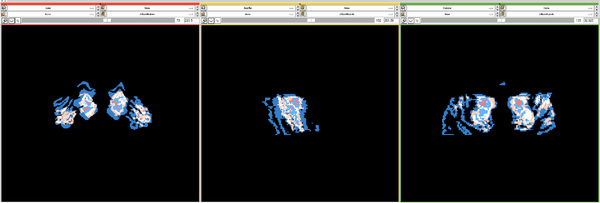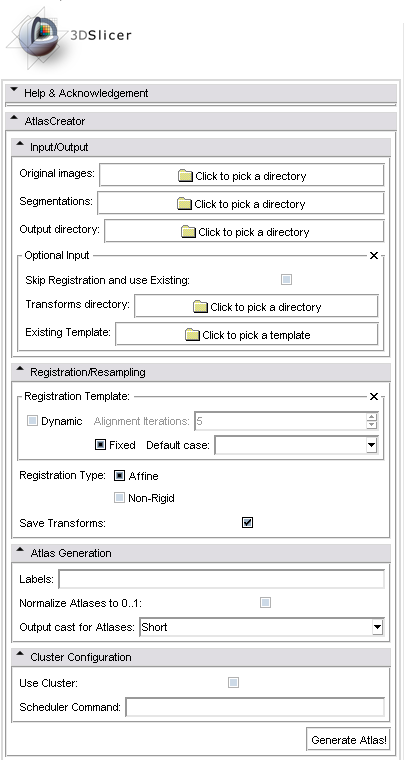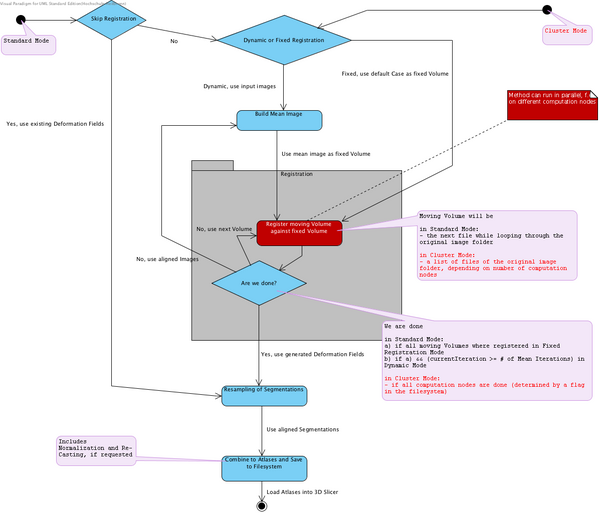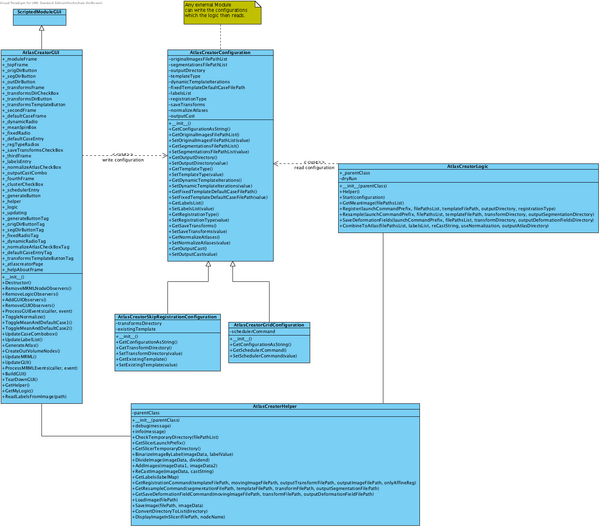Projects:ARRA:SlicerEM:AtlasCreator
Atlas Creator
The Atlas Creator combines existing segmentations to an anatomical atlas based on robust statistics.
Examples
The following example was created using 6 different cases, aligned against a Fixed Template. It took about 25 Mins on a 4 Core Xeon System with 3 GHz and visualized using the default labelMap colors.
GUI
The following screenshot shows the graphical user interface of the Atlas Creator module in 3D Slicer Version 3.
Priority List
The priority list reflects the open issues.
Re-structure Atlas Creator code according to the Design specified belowImplement dynamic registration- Watch out for overflows
Implement support for parallel ComputationAdd Helpand Online Documentation- check how to include C++ code in AtlasCreator
- create concept
- make KilisSandbox work with PCA
- create AtlasCreator MRML Node
- update documentation page
- include CMTK as alternative to BRAINSFit
- Include PCA functionality in AtlasCreator
Design
The following State Machine diagram shows the flow of the Atlas Creator logic. It can be run in two modes:
- Normal mode, all computations on one machine
- Cluster mode, parallelized computations
The following class diagram shows the structure of the module.
Proposal: Configuration of the Atlas Creator logic
The Atlas Creator supports different modes of operation. For now, we focus on Skip Registration Mode, Normal Mode and Cluster Mode.
To configure an Atlas Creator operation, we introduce configuration containers. The following example shows how to create the configuration:
# configuration for a Normal Mode operation
configuration = AtlasCreatorConfiguration()
# define the parameters
configuration.SetTemplateType("fixed")
...
self._logic.Start(configuration)
# configuration for a Cluster Mode operation
gridConfiguration = AtlasCreatorGridConfiguration()
# define the same parameters as above
gridConfiguration.SetTemplateType("fixed")
...
# and also additional cluster specific parameters
gridConfiguration.SetSchedulerCommand("stageClusterJob.sh")
...
self._logic.Start(configuration)
The logic detects which operation scenario was configured and then adjusts the workflow accordingly. This concept can be easily extended for future operation modes.
Proposal: Running the Atlas Creator in a Grid Environment
The Atlas Creator concept supports parallelized computations. An existing grid environment can be leveraged during the Registration phase as shown in the diagram above.
Only the Registration can be performed parallelized since it is the most time-consuming task in the Atlas Creator pipeline.
The Atlas Creator module runs on one node in the cluster (most likely the head node) and then generates bash scripts which start the registration using the 3D Slicer launch mechanism. These scripts can be run using an existing scheduler or a similar mechanism and use the Python invokation method shown in the section below. An existing $DISPLAY environment is not necessary for using the 3D Slicer launch mechanism.
The module immediately recognizes if the parallelized registration jobs are complete and then continues the pipeline on the node where the it was first started.
Input for Parallelized Computation
- Optional: Command for scheduling the generated bash scripts. This command will be run with the generated bash scripts as individual arguments.
- Optional: Path to 3D Slicer (must be a network installation reachable by each node)
- Optional: The temporary directory to be used by the 3D Slicer launch mechanism
- Optional: The config file directory to be used by the 3D Slicer launch mechanism
- The number of different computation nodes. The Atlas Creator will use this number to distribute the parallelized registration among the input images.
Proposal: Invoking the Atlas Creator via Python
The Atlas Creator logic can be invoked via Python. This includes running the Atlas Creator from Command Line and invoking the Atlas Creator from another 3D Slicer module or the 3D Slicer Python console.
To access the Atlas Creator logic, the following snippet is useful:
from Slicer import slicer # get the path to the Atlas Creator module pathToAtlasCreator = str(slicer.Application.GetModulePaths()) + '/AtlasCreator' # add it to the python sys path sys.path.append(pathToAtlasCreator) # import the Atlas Creator module from AtlasCreatorGUI import * # instantiate the Atlas Creator gui, needed for debug statements on the console # and automatically creates the logic gui = AtlasCreatorGUI() # get the Atlas Creator logic logic = gui.GetMyLogic() # create configuration configuration = AtlasCreatorConfiguration() # configure now using the setters... # work with the logic logic.Start(configuration)
Running the Atlas Creator from Command Line
The snippet from above can be saved as a Python script which can be directly run using the 3D Slicer launch environment.
To invoke, use the following command:
./Slicer3 -p Script.py



